-
Nurture Kids With Nutrition

You sowed a few seeds in the ground but did not care about their development, what do you expect?
If your answer is a big healthy tree, you may be disappointed, as seeding is not just enough, although the seed may sprout into a plant in its natural course of growth if you are ambitious about its development you need to nourish the seed.
Now just replace this scenario with a kid at your home, YES! he will grow in age, height and weight but if he is taken care of at the dietary level, he may outgrow the others of his age.
Good nutrition supports your child’s health, growth, and development, A healthy diet stabilizes your child’s energy, keeps their bones strong, supports their mental health, promotes a healthy weight, and prevents chronic diseases.
Nutrishilp advocates saying Hi Five to your child. Saying it literally and loudly will make their day and applying it to their diet will make them healthier and less prone to disease.
The HI Five are five food groups –
1.Grain (cereal) foods
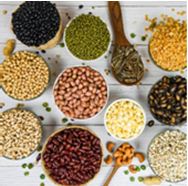
Always choose wholegrain and/or high-fibre varieties of bread, cereals, rice, pasta, noodles, etc. Refined grain products (such as cakes or biscuits) can be high in added sugar, fat and sodium.
The less processed the grains, the better.
2.Pulses and legumes
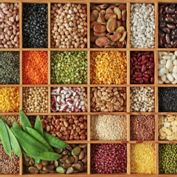
All pulses share an important characteristic: they contain a similar amount of proteins to meat, although their nutritional quality is lower than proteins from animal sources (provided by eggs, meat, fish and dairy products), as they do not contain certain amino acids that the body needs. In any case, this is not a problem. In particular, pulses lack methionine and cysteine, substances that are found in cereal-based proteins. These, in turn, lack an essential amino acid, lysine, which is present in legumes. Consequently, all you have to do is combine pulses with cereals for them to complement each other, resulting in a highly nutritious mixture.
To ensure a perfect combination, half of the proteins should come from pulses and the other half from cereals. In practice, you can prepare a combination consisting of two-thirds cereals and one-third pulses, which are more or less the proportions recommended for preparing many dishes, such as pasta with chickpeas, beans, rice or peas.
3.Nuts and oil seeds
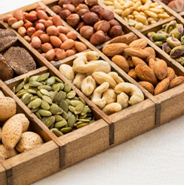
Our bodies use the protein we eat to make specialised chemicals such as haemoglobin and adrenalin. Protein also builds, maintains, and repairs the tissues in our body. Muscles and organs (such as your heart) are primarily made of protein.
Nuts and oilseeds are dense in nutrition with excellent flavour.
Crunchy, filling, and nutritious, nuts are fantastic food to have on hand.
They’re a good source of fibre, healthy fats, and plant protein. Plus, they’re great on their own, paired with fruit, or added to dishes like salads, desserts, and grains.
Due to the dense nutrition profile of nuts and oilseeds such as garden cress seeds, gingelly seeds etc., they provide several health benefits- lower the risk of cardiovascular disease, help in weight management, lower the risk of diabetes, prevent cancer and osteoporosis.
4.Fruits and Vegetables
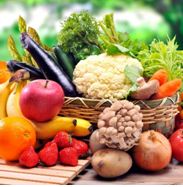
Fruit: Fruit provides vitamins, minerals, dietary fibre and many phytonutrients (nutrients naturally present in plants), that help the body stay healthy.
Eat plenty of fruits of all colours.
Choose whole fruits or sliced fruits (rather than fruit juices; limit fruit juice to one small glass per day).
Vegetables – Vegetables should make up a large part of your daily food intake and should be encouraged at every meal (including snack times). They provide vitamins, minerals, dietary fibre and phytonutrients (nutrients naturally present in plants) to help your body stay healthy.
A balanced diet for kids contains plenty of fruits and vegetables, along with whole grains and protein.
The more veggies – and the greater the variety – the better.
Potatoes and French fries don’t count as vegetables because of their negative impact on blood sugar.
5.Dairy /Poultry / Meat
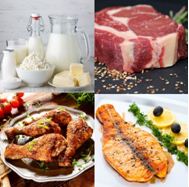
The foods in this group are excellent sources of calcium, which is essential for strong and healthy bones. Not many other foods in our diet contain as much calcium as these foods.
Choose unflavoured milk, plain yogurt, small amounts of cheese, and other unsweetened dairy foods.
Additionally, fish, eggs, and poultry can also serve as a good source of protein for kids. Also, meat can be a rich source of vitamins, minerals, protein and healthy fat.
It’s also important to remember that fat is a necessary part of our diet, and what matters most is the type of fat we eat. We should regularly choose foods with healthy unsaturated fats (such as fish, nuts, seeds, and healthy oils from plants), limit foods high in saturated fat (especially red meat), and avoid unhealthy trans fats (from partially hydrogenated oils):
Use healthy oils from plants like extra virgin olive, canola, corn, sunflower, and peanut oil in cooking, on salads and vegetables, and at the table. Limit butter to occasional use.
6.Water
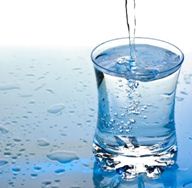
It’s always important for kids to meet their daily fluid needs. Water is abundant in the brain, heart, lungs, skin, and even bones. The vital nutrient helps control body temperature, supports healthy digestion, brings wastes out of the body, prevents constipation, and much more. Keep reading to learn how much water your kid should drink, with tips for staying hydrated throughout the day.
7.EAT A RAINBOW
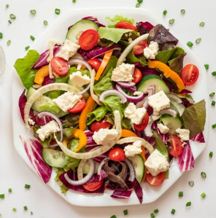
Why are there so many songs about rainbows? Because they’re amazing and beautiful—not just in the sky, but also on the dining table! “Eating a rainbow” helps your body get a complete range of nutrien
What does it mean to eat a rainbow?
Choosing a variety of different coloured whole foods throughout the day and week.
The more naturally occurring colours on your plate at each meal or snack, the better.
It does not mean making a rainbow with artificially coloured foods (gummy snacks, soda, popsicles, etc.) but natural food.
Nutrishilp recommends a plate that’s half-full of colourful veggies with the other half split between lean protein and whole grains (like whole wheat pasta or brown rice).
What to avoid –
Parents should aim to limit their child’s calories from:
Added sugar. Naturally occurring sugars, such as those in fruit and milk, aren’t added sugars. Examples of added sugars include brown sugar, corn sweetener, corn syrup and honey. To avoid added sugar, check nutrition labels. Choose cereals with minimal added sugars. Avoid sodas and other drinks with added sugars. Limit juice servings. If your child drinks juice, make sure it’s 100% juice without added sugars.
Saturated fats. Saturated fats mainly come from animal sources of food, such as red meat, hot dogs, poultry, butter and other full-fat dairy products. Pizza, sandwiches, burgers and burritos are common sources of saturated fat. Desserts such as cakes and ice cream are another common source of saturated fat. When cooking, look for ways to replace saturated fats with vegetable and nut oils, which provide essential fatty acids and vitamin E.
Salt. Another name for salt is sodium. Salt can hide in sandwiches, where the sodium in bread, meat, condiments and toppings adds up. Processed foods, such as pizza, pasta dishes and soup, often have high amounts of salt. Encourage snacking on fruits and vegetables instead of chips and cookies. Check nutrition labels and look for products low in sodium.
Additional tips for Parents –
It’s no surprise that parents might need some help understanding what it means to eat healthily., it can be confusing.
The good news is that you don’t need a degree in nutrition to raise healthy kids. Following some basic guidelines from Nutrishilp can help you encourage your kids to eat right and maintain a healthy weight.
Here are 8 key rules to live by:
Parents control the supply lines. You decide which foods to buy and when to serve them. Though kids will pester their parents for less nutritious foods, adults should be in charge when deciding which foods are regularly stocked in the house. Kids won’t go hungry. They’ll eat what’s available in the cupboard and fridge at home. If their favourite snack isn’t all that nutritious, you can still buy it once in a while so they don’t feel deprived.
Quit the “clean-plate club.” Let kids stop eating when they feel they’ve had enough. Lots of parents grew up under the clean-plate rule, but that approach doesn’t help kids listen to their bodies when they feel full. When kids notice and respond to feelings of fullness, they’re less likely to overeat.
Start them young. Food preferences are developed early in life, so offer variety. Likes and dislikes begin forming even when kids are babies. You may need to serve a new food a few different times for a child to accept it. Don’t force a child to eat, but offer a few bites. With older kids, ask them to try one bite.
Rewrite the kids’ menu. Who says kids only want to eat hot dogs, pizza, burgers, and macaroni and cheese? When eating out, let your kids try new foods and they might surprise you with their willingness to experiment. You can start by letting them try a little of whatever you ordered or ordering an appetizer for them to try.
Drink calories count. Soda and other sweetened drinks add extra calories and get in the way of good nutrition. Water and milk are the best drinks for kids. Juice is fine when it’s 100%, but kids don’t need much of it — 4 to 6 ounces a day is enough for pre-schoolers.
Put sweets in their place. Occasional sweets are fine but don’t turn dessert into the main reason for eating dinner. When dessert is the prize for eating dinner, kids naturally place more value on the cupcake than the broccoli. Try to stay neutral about foods.
Food is not love. Find better ways to say “I love you.” When foods are used to reward kids and show affection, they may start using food to cope with stress or other emotions. Offer hugs, praise, and attention instead of food treats.
Limit screen time. When you do, you’ll avoid mindless snacking and encourage activity. Research has shown that kids who cut down on TV watching also reduced their percentage of body fat. When TV and computer time are limited, they’ll find more active things to do. And limiting “screen time” means you’ll have more time to be active together.
“As they say Example is better than precept; before and after all the suggestions and tips it’s equally important to be the perfect Role model for your child, be strict with yourself along with designing the dietary chart for the kid.”
Shilpi Goel, Dietician and Wellness Expert, Founder Nutrishilp
-
Fatty Liver and Diet
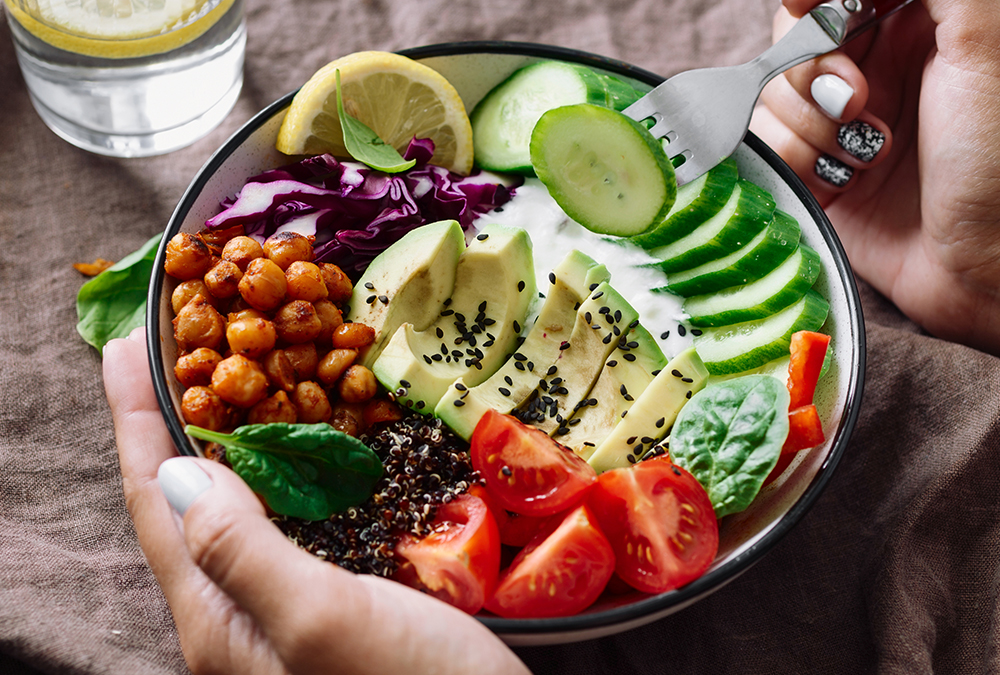
The liver is an incredible multitasker. You can think of this vital organ as a filter system. It helps your body get rid of toxins while also harvesting nutrients from the foods you eat.
What is Fatty Liver Disease?
In very simple words,having a fatty liver means you have extra fat in your liver this condition may be medically addressed as hepatic steatosis.
Most commonly heavy drinking makes you more likely to get it. Over time, too much alchohol leads to a buildup of fat inside your liver cells. This makes it harder for your liver to work. But you can get fatty liver disease even if you don’t drink a lot of alcohol
Nonalcoholic Fatty Liver Disease (NAFLD)
There are two different types of nonalcoholic fatty liver disease:
Simple fatty liver: This means you have fat in your liver, but you may not have any inflammation in your liver or damage to your liver cells. It usually doesn’t get worse or cause problem with your liver. Most people with NAFLD have simple fatty liver.
Nonalcoholic steatohepatitis (NASH): This is much more serious than a simple fatty liver. NASH means you have inflammation in your liver. The inflammation and liver cell damage that happen with NASH can cause serious problems such as fibrosis and cirrhosis which are types of liver scarring, and liver cancer.
Alcohol-Related Fatty Liver Disease (ALD)
Alcoholic fatty liver disease is preventable. It usually gets better when you stop drinking alcohol. If you keep drinking, ALD can cause serious problems. These include:
• Enlarged Liver . It doesn’t always cause symptoms, but you may have pain or discomfort on the upper right side of your belly.
• Alcoholic Hepatitis. This is swelling in the liver that can cause fever, nausea vomiting, belly pain, and jaundice .
• Alcoholic cirrhosis. This is a buildup of scar tissue in your liver. It can cause the same symptoms as alcoholic hepatitis plus:
o Large amounts of fluid buildup in your belly which is called ascites.
o High Blood Pressure in the liver
o Bleeding in your body
o Confusion and changes in behavior
o Enlarged Spleen
o the most fatal is Liver Failure.As it very evident, that Alcohol-Related Fatty Liver Disease (ALD) can be avoided by limiting or nullfying the alcohol consumption .
This Nutrishilp blog will guide you to deal with the category of Nonalcoholic Fatty Liver Disease (NAFLD)
In a healthy body, the liver removes toxins and produces bile, a protein that breaks down fat into fatty acids so that they can be digested. Fatty liver disease damages the liver and prevents it from working as well as it should, but lifestyle changes can prevent it from getting worse.
The first line of treatment for NAFLD is weight loss, through a combination of calorie reduction, exercise and healthy eating.
In general, the diet for fatty liver disease includes:
• fruits and vegetables
• high-fiber plants like lelegumes and whole grains
• significantly reducing intake of certain foods and beverages including those high in added sugar, salt,refined carbohydrates and saturated fat
• Off course no alcohol.The amount of weight that you should lose to treat NAFLD will depend on the amount of excess body fat that you have. Team Nutrishilp can help you decide on an appropriate weight loss goal based on your overall health. A nutrient-dense, whole-food-based diet rich in fiber, protein, and unsaturated fats generally recommended for those with NAFLD.
Foods to Help Fatty Liver Reversal
Healthy eating is one of the first lines of treatment for fatty liver disease.
Here are a few foods to include in your healthy liver diet:
1.Coffee to help lower abnormal liver enzymes
Your daily cup of coffee could help protect your liver against NAFLD. Regular coffee consumption is associated with a lowered risk of developing NAFLD, as well as a decreased risk of the advancement of liver fibrosis in those already diagnosed with NAFLD. Caffeine also appears to lower the number of abnormal liver enzyme in people at risk for liver diseases.
2.Greens to prevent fat buildup
Compounds found in leafy greens as spinach may help fight fatty liver disease. For instance spinach specifically lowers the risk of NAFLD, due to the nitrate and distinct polyphenols found in the leafy green. As a matter of fact the raw may serve the purpose more than cooked spinach because cooking spinach (and other leafy greens) may result in lowered polyphenolic content and antioxidant activity.
3.Beans and soy to reduce the risk of NAFLD
Both beans and soy have shown promise when it comes to reducing the risk of NAFLD. Legumes such as lentils, chickpeas, soybeans, and peas are not only nutritionally dense foods, but also contain resistant starches that help improve gut health. Consumption of legumes may even help lower blood glucose and triglycerides in individuals living with obesity.
Also eating soy may help protect the liver, most likely because soy contains a high content of the protein β-conglycinin — noted for its ability to help lower triglyceride levels and possibly protect against visceral fat buildup.
Additionally, tofu is a low-fat food that serves as a good source of protein, making it an ideal choice if you’re trying to limit your fat consumption.
4.Fish to reduce inflammation and fat levels
Fatty fish such as salmon,sardines, tuna and trout are high in omega-3 fatty acids suggests that supplementing with omega-3s may benefit those with NAFLD by reducing liver fat, boosting protective HDL cholesterol, and lowering triglyceride levels.
5.Complex carbohydrates
While your entire diet shouldn’t consist of carbohydrates, you do want to eat a balance of carbs, protein, and healthy fats. Complex carbohydrates are better than simple carbs because they’re metabolized slower and prevent wide fluctuations in blood sugar. This is why it’s best for people with NAFLD to choose complex carbs over simple carbs. Nonrefined carbs also have essential nutrients like zinc, B vitamins, and higher fiber levels, which are all important for a healthy liver and metabolism. The key is selecting whole grain carbs, such as:
wild rice, whole wheat bread and pasta, brown rice, whole oats, rye, corn and bulgur.
6.Fiber rich diet
Whole-grain, fiber-rich foods like oatmeal are associated with a reduced risk of NAFLD-related diseases.
A nutritious diet rich in high fiber foods like oats is effective for those with NAFLD and may help reduce triglyceride levels.7.Nuts to help reduce inflammation
A diet rich in nuts is associated with reduced inflammation, insulin resistance, and oxidative stress and a lower prevalence of NAFLD.
8.Turmeric to reduce markers of liver damage
High doses of curcumin— the active ingredient in turmeric— might reduce markers of liver damage in people with NAFLD.
Turmeric may decrease levels of serum alanine aminotransferase (ALT) and aspartate aminotransferase (AST) — two enzymes that are abnormally high in people with fatty liver disease.
9.Sunflower seeds for antioxidants
Sunflower seeds are particularly high in ,vitamin E, an antioxidant used for
(via supplementation) in the treatment of NAFLD.While most research around NAFLD and vitamin E focuses on supplements, a 100-gram serving of sunflower seeds has about 20 milligrams of vitamin E, more than 100 percent of the Daily Recommended Value. If you’re looking to increase your vitamin E consumption naturally, sunflower seeds are a good starting point.
10.Garlic to improve overall health
This vegetable not only adds flavor to food, but small experimental studies also show that garlic powder may help reduce body weight and fat in people with fatty liver disease.
In addition to modifying your diet, here are a few other lifestyle changes you can make to improve your liver health:
- Get active. Exercise, paired with diet, can help you lose weight and manage your liver disease. Aim to get at least 30 minutes of aerobic exercise on most days of the week.
- Lower blood lipid levels. Watch your saturated fat and sugar intake to help keep your cholesterol and triglyceride levels under control. If diet and exercise aren’t enough to lower your cholestrol, medical advice must be sought.
- Control diabetes.Diabetes and fatty liver disease often occur together. Diet and exercise can help you manage both conditions. If your blood sugar is still high, your doctor can prescribe medication to lower it.
Knowing what not to do is as important as knowing What to do?Thus, Nutrishilp suggests few food which should be avoided –
if you have fatty liver disease
If you have fatty liver disease, your doctor may recommend avoiding certain foods — or at least eating them sparingly. These foods generally contribute to weight gain and can increase blood sugar.
Avoid when possible
• Alcohol. Alcohol can be a major cause of fatty liver disease as well as other liver diseases.
• Added sugar. Stay away from sugary foods such as candy, cookies, sodas, and fruit juices. High blood sugar increases the amount of fat buildup in the liver.
• Fried foods. These are high in fat and calories.
• Added salt. Consuming too much salt can increase the risk of NAFLD. It’s recommended to limit sodium intake to less than 2,300 milligrams per day. People who have high blood pressure should limit salt intake to no more than 1,500 mg per day
• White bread, rice, and pasta. White flour is typically highly processed, and items made from it can raise your blood sugar more than whole grains, due to a lack of fiber.
• Red meat. Beef and deli meats are high in saturated fat.Takeaway
As a general rule, whole foods are best for your liver and the rest of your body. When it comes to adding foods to your diet, your doctor or a registered dietitian is your best resource for knowing the best foods for you.
Certain liver conditions may require a more specialized diet. In some cases, people with advanced liver disease may not be able to absorb the fats they eat and may have to limit oils and fatty fish.
Typically, it’s recommended for people with hemochromatosis to avoid consuming iron, while those with hepatitis C may need to limit their intake of iron and salt.
Your doctor or dietitian can tell you more about which foods to eat and which to avoid.
Nutrishilp advices to contact your doctor if you lose a lot of weight in a short amount of time despite eating liver-friendly foods.This could mean that your liver isn’t processing nutrients effectively. In addition Nutrishilp dietitians may also advise you about any changes you may need to make to your diet.
And as last token of advice remember, before making any big change to your diet, check with your doctor or a registered dietitian.
“Do not be deceived by the name , fatty liver is a diesease that can happen to normal weight people also..not only to Fat ones.”
- Shilpi Goel , Nutritionist and Dietician, founder Nutrishilp
Follow this space for more blogs on health and related issues.
-
Eating Disorder

“I felt empty, so I ate. Then I felt guilty, so I got rid of it”, “Everyone lied to me about my weight. They said I was thin; I knew that wasn’t true”. “Once I started eating, I couldn’t stop, no matter what anyone said or did.”
These are the voices of eating disorders.
Although the term “Eating” is in the name, eating disorders are about more than food. They’re complex mental health conditions. Because of the physical nature of their defining symptoms, eating disorders can cause both emotional distress and significant medical complications.
Let’s begin to explore this complexity with this Nutrishilp blog –
What is an eating disorder?
Eating disorders are a range of psychological conditions that cause unhealthy eating habits to develop. Self-image, food, eating, and body weight each become a source of serious anxiety for people and they experience distorted thinking and behaviors that cause problems in their lives.
What causes eating disorders?
Experts believe that a variety of factors may contribute to eating disorders.
Genetics – People who have a sibling or parent with an eating disorder seem to be at an increased risk of developing one.
Personality traits are another factor. In particular, neuroticism, perfectionism, and impulsivity are three personality traits often linked to a higher risk of developing an eating disorder.
Cultural preferences – It does happen in our society, having preferences to people on the basis of body shape as preference to thinness. These presumptions create pressure on those not falling on the line. At times to imitate celebrities (who have experts to guide on their health) people fall prey of such disorders.
Types of eating disorders
Eating disorders are a group of related conditions involving extreme food and weight issues, but each disorder has unique symptoms and diagnosis criteria. Here are six of the most common eating disorders and their symptoms.
- Anorexia nervosa is likely the most well-known eating disorder. It generally develops during adolescence or young adulthood and tends to affect more women than men.
People with anorexia generally view themselves as overweight, even if they’re dangerously underweight. They tend to constantly monitor their weight, avoid eating certain types of foods, and severely restrict their calorie intake.
Common symptoms of anorexia nervosa include
• very restricted eating patterns
• intense fear of gaining weight or persistent behaviors to avoid gaining weight, despite being underweight
• a relentless pursuit of thinness and unwillingness to maintain a healthy weight
• a heavy influence of body weight or perceived body shape on self-esteem
• a distorted body image, including denial of being seriously underweightHowever, it’s important to note that weight should not be the major focus of diagnosing someone with anorexia. They may also have difficulty eating in public and exhibit a strong desire to control their environment, limiting their ability to be spontaneous. Anorexia is officially categorized into two subtypes — the restricting type and the binge eating and purging type
Individuals with the restricting type lose weight solely through dieting, fasting, or excessive exercise. Individuals with the binge eating and purging type may binge on large amounts of food or eat very little. In both cases, after they eat, they purge using activities such as vomiting, taking laxatives or diuretics, or exercising excessively.
Anorexia can be very damaging to the body. Over time, individuals living with it may experience thinning of their bones, infertility, and brittle hair and nails. In severe cases, anorexia can result in heart, brain, or multi-organ failure and death.
- Bulimia nervosa is another well-known eating disorder.
It also tends to develop during adolescence and early adulthood and appears to be less common among men than women. People with bulimia frequently eat unusually large amounts of food in a specific period of time.
Each binge eating episode usually continues until the person becomes painfully full. During a binge, the person usually feels that they cannot stop eating or control how much they are eating. Binges can happen with any type of food but most commonly occur with foods the individual would usually avoid.
Individuals with bulimia then attempt to purge to compensate for the calories consumed and to relieve gut discomfort. Common purging behaviors include forced vomiting, fasting, laxatives, diuretics, enemas, and excessive exercise.
Symptoms may appear very similar to those of the binge eating or purging subtypes of anorexia nervosa. However, individuals with bulimia usually maintain a relatively typical weight rather than losing a large amount of weight.
Common symptoms of bulimia nervosa include
• recurrent episodes of binge eating with a feeling of lack of control
• recurrent episodes of inappropriate purging behaviors to prevent weight gain
• self-esteem overly influenced by body shape and weight
• a fear of gaining weight, despite having a typical weightSide effects of bulimia may include an inflamed and sore throat, swollen salivary glands, worn tooth enamel, tooth decay, acid reflux, irritation of the gut, severe dehydration, and hormonal disturbances.
In severe cases, bulimia can also create an imbalance in levels of electrolytes, such as sodium, potassium, and calcium. This can cause a stroke or heart attack.
- Binge eating disorder is the most prevalent form of eating disorder and one of the most common chronic illnesses among adolescents.
It typically begins during adolescence and early adulthood, although it can develop later on. Individuals with this disorder have symptoms similar to those of bulimia or the binge eating subtype of anorexia.
For instance, they typically eat unusually large amounts of food in relatively short periods of time and feel a lack of control during binges. People with binge eating disorder do not restrict calories or use purging behaviors, such as vomiting or excessive exercise, to compensate for their binges.
Common symptoms of binge eating disorder include –
• eating large amounts of food rapidly, in secret, and until uncomfortably full, despite not feeling hungry
• feeling a lack of control during episodes of binge eating
• feelings of distress, such as shame, disgust, or guilt, when thinking about the binge eating behavior
• no use of purging behaviors, such as calorie restriction, vomiting, excessive exercise, or laxative or diuretic use, to compensate for the binge eatingPeople with binge eating disorder often consume an excessive amount of food and may not make nutritious food choices. This may increase their risk of medical complications such as heart disease, stroke, and type 2 diabetes.
- Pica is an eating disorder that involves eating things that are not considered food and that do not provide nutritional value.
Individuals with pica crave non-food substances such as ice, dirt, soil, chalk, soap, paper, hair, cloth, wool, pebbles, laundry detergent, or cornstarch.
Pica can occur in adults, children, and adolescents.
It is most frequently seen in individuals with conditions that affect daily functioning, including intellectual disabilities, developmental conditions such as autism spectrum disorder, and mental health conditions such as schizophrenia .
Individuals with pica may be at an increased risk of poisoning, infections, gut injuries, and nutritional deficiencies. Depending on the substances ingested, pica may be fatal.
- Rumination disorder can be described as a condition in which a person regurgitates food they have previously chewed and swallowed, re-chews it, and then either re-swallows it or spits it out …
This rumination typically occurs within the first 30 minutes after a meal.
This disorder can develop during infancy, childhood, or adulthood. In infants, it tends to develop between 3 and 12 months of age and often disappears on its own. Children and adults with the condition usually require therapy to resolve it.
If not resolved in infants, rumination disorder can result in weight loss and severe malnutrition that can be fatal. Adults with this disorder may restrict the amount of food they eat, especially in public. This may lead them to lose weight and become underweight.
- Avoidant/restrictive food intake disorder consists of disturbed eating due to either a lack of interest in eating or a distaste for certain smells, tastes, colors, textures, or temperatures.
Common symptoms of ARFID include –
• avoidance or restriction of food intake that prevents the person from eating enough calories or nutrients
• eating habits that interfere with typical social functions, such as eating with others
• weight loss or poor development for age and height
• nutrient deficiencies or dependence on supplements or tube feedingIt’s important to note that ARFID goes beyond common behaviors such as picky eating in toddlers or lower food intake in older adults. Moreover, it does not include the avoidance or restriction of foods due to lack of availability or religious or cultural practices.
“How do I know if I have an eating disorder?”
And it’s kind of tricky to know, honestly. Eating is something we all do every day in our lives and thinking about food, or thinking about dieting or losing weight is kind of a normal part of life in our culture. When it crosses over to being a serious problem, it’s often when you notice that you’re thinking about it all the time. You’re getting anxious about what you’re going to eat or not eat. You’re thinking a lot about your body, how you look, wanting to look different.
It becomes an obsession, almost. Something you can’t get out of your head, something you organize your day around. When it crosses over into being really an eating disorder is when those thoughts and behaviors are really starting to impact your life, how you do things socially. Maybe you’re avoiding eating with other people.
And it can absolutely get to the point where your health is very seriously impacted.
Eating disorders take a lot of different forms. But basically, when you find yourself thinking a lot about food and your body, and changing the way you eat, you’re probably on the road to developing an eating disorder.Treatment for Eating Disorders
Self-Help
Some people with bulimia nervosa and binge eating disorder may explore self-help or guided-self-help based on cognitive-behavioral therapy (CBT) principles. The person may work through a workbook, manual, or web platform to learn about the disorder and develop skills to overcome and manage it.
Cognitive Behavioral Therapy (CBT)
CBT is the best-studied outpatient therapy for adult eating disorders and includes elements as Cognitive restructuring, Body image exposure, Delays and alternatives, Food exposure, Limiting body-checking, Meal planning, Regular eating, Relapse prevention, Guided self-monitoring
Family-Based Treatment (FBT)
Family-based treatment (FBT) is the best-studied treatment for children and adolescents with eating disorders. Essentially, the family is a vital part of the treatment team. Parents commonly provide meal support, which allows the young person to recover in their home environment. Another important element of FBT is externalizing the eating disorder.
Nutritional Therapy
A registered dietitian can help you learn (or relearn) the components of a healthy diet and motivate you to make the needed changes.
Coping With an Eating Disorder
Caring for your physical and mental health will go a long way toward helping you cope with an eating disorder. In addition to talking to a therapist or joining a support group, seek support from a trusted friend or family member who can be there for you along your path to recovery.
Beyond self-care, it’s also essential to identify a few healthy distractions you can turn to when you find yourself obsessing about food and weight or experiencing the urge to turn to disordered eating or behaviors, as Explore a new hobby, like photography, painting, or knitting.
“One should be thoughtful about health but as an old Indian saying: atisarvtravarjyet, one should not OVER DO, accept the limitations too, thus eat to support your natural body type, do consult for an advice when you feel like burdened with your body shape, size or self-image. Learn to appreciate yourself.”
Shilpi Goel, Dietitian and Nutritionist
-
The Vegan Diet – “Birds are good but not for food”
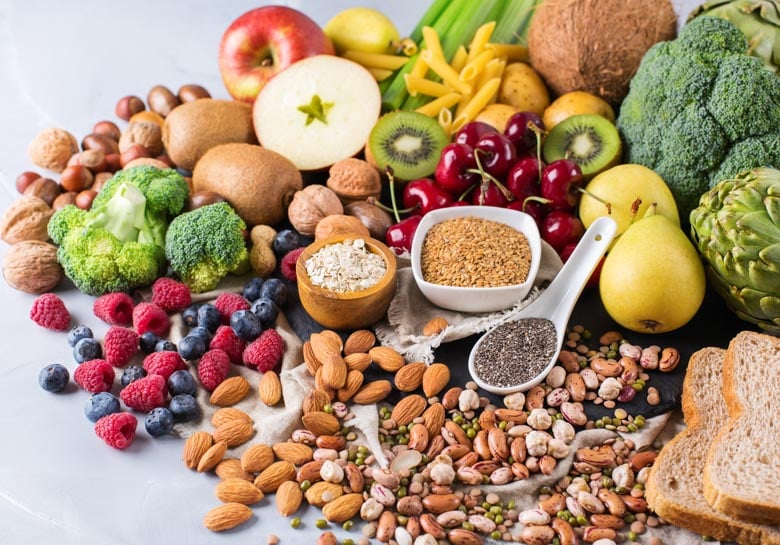
The concept of “veganism” or a vegan diet has gained a huge amount of popularity and buzz over the past one decade.
Vegan diet or veganism is a lifestyle where one does not consume any kind or type of animal bases produced, when it comes to their food choices or lifestyle choices. One totally avoids all types of products derived from animals. So, one even can’t consume milk cheese, milk curd, milk, and any other product derived from them,in fact a true vegan will not consume honey also.
Every November, World Vegan Month is celebrated around the world as a time to shine a light on the vegan movement and the very 1st day is marked as World Vegan Day.
Veganism is an extension of being vegetarian. In a way all sorts of practices that cause cruelty or suffering to animals are discouraged by vegans. The concept has gained popularity not only because of emotional appeal in it but also for health benefits as
Reduce your cholesterol levels
Vegan diet is heart-friendly too, as your heart health is one of the most essential aspects of your health, and since a vegan diet is low in saturated fats and bad fats that lead to the blockage of arteries in your body and which might lead to poor heart health in future, also vegan diet is something that has adequate amount fiber that allows your body to maintain a healthy balance of LDL (Bad cholesterol) and HDL (Good Cholesterol), that ensures the healthy functioning heart.
Also, a vegan diet is rich in many micronutrients which are shown to improve the blood flow in your body, which further improves heart health. Since your heart health depends upon factors like the balance of cholesterol levels, the number of triglycerides, and previous parental history and adding plant-based foods or following a vegan diet has shown tremendous effects on one’s heart health.
Better Digestion
Digestion is one factor that is one of the most important elements for good health, if your digestion is messed up there wouldn’t be any point in eating good quality food, now since the foods that you eat in a vegan lifestyle (healthy ones obviously) are rich in fiber, which improves your body ability to process digestion better and give you a healthy stool.
as you tend to focus more on veggies, fruits, nuts, and plant-based milk, it creates an optimal environment in your body that helps to reduce the number of androgens in your body, giving you that glowing and ageless skin.
Weight loss
one of the many reasons why people switch to a vegan lifestyle is the favorite benefit of all times, weight loss, now we are not saying that the moment you switch to a vegan lifestyle you will end up losing tons of weight but choosing a vegan lifestyle can surely help you in your weight loss ho as you get a variety of foods to choose by in vegan lifestyle that are satiating and yet low in calories, for instance, plant-based milk like almond and oats milk is quarter to that of cow’s milk in terms of calories.
and to active weight loss, one has to create some set of calories deficit in their daily diet, and adding plant-based foods or opting for a vegan lifestyle can definitely help one to achieve so.
Great for your skin as well
This is might not be true for everyone but for many people consuming animal products like milk can cause a rapid increase of androgens in their body which may lead to acne breakout or oily skin,
Opting for or adding some plant-based foods, plant-basedprotein like fruits, veggies, and plant-based milk can help you to reduce inflammation in your body and give you good glowing skin. Trust us no cream can do the magic that a healthy lifestyle and diet can do.
In a nutshell, on a vegan diet, you can eat foods made from plants, including:
- Fruits and vegetables
- Legumes such as peas, beans, and lentils
- Nuts and seeds
- Breads, rice, and pasta
- Dairy alternatives such as soymilk, coconut milk, and almond milk
- Vegetable oils
Studies show that vegans have better heart health and lower odds of having certain diseases. Those who skip meat have less of a chance of becoming obese or getting heart disease, high cholesterol, and high blood pressure. Vegans are also less likely to get diabetes and some kinds of cancer, especially cancers of the GI tract and the breast, ovaries, and uterus in women.
But every coin has two faces, Team Nutrishilp suggests you to understand the drawbacks of Vegan, so that you your decision to dietary shift will be more informed.
Those who are into extreme dieting tend to take supplements for the nutrients they get deficient of. Vegan food cannot provide a high amount of energy for exercise purposes.
Dangers of being Vegan
LEGUME PROTEIN AND LEAKY GUT
Avegan can not include any kind of animal protein, thus legumes become a major plant-based protein source.
Proteins present in legumes also contain certain anti nutrients. These anti nutrients have the property to inhibit the absorption of important macronutrients, vitamins and minerals.
Leaky gut is a condition of an intestine which is also known as intestinal permeability. In this, the lining of the small intestine gets damaged by accumulation of anti-nutrient. This lets the undigested food particles, toxic waste products and bacteria to leak through the intestine and reach to the bloodstream.
SOY PROTEIN AND HORMONE DISRUPTION
The fact that a vegan cannot have a stable protein source, they need to find certain food products which are rich in proteins. Soya bean is such plant-based food which is rich in protein source and provides many other macronutrients.
Soya beans also consist of phytoestrogens which increases the estrogen levels in the body. Phytoestrogen is given as a supplement to the women during their menopause for the smooth procedure. This elevation of estrogen levels can create imbalance in the body.
LACK OF HEMOGLOBIN
The major source of hemoglobin has always been red meat. For vegans, there are very less heme options, even if there are then those are non heme iron. Non heme iron has a drawback that they do not get absorbed by the body that readily.
In India, iron deficient anemia is the most common form of anemia and also nutritional deficiency. Both vegan and vegetarian diets are at high risk of anemia.
REDUCTION IN OMEGA 3 FATTY ACID
Omega 3 fatty acid is the major component of fish and fish oils. Although the increased amount of it can be unhealthy for the body but if there is excessively decreased amount of the same then it can affect the body in worsened forms.
For fully vegans, omega 3 fatty acid doesn’t have any vegan food substitute which can take the place of fish completely.
TOO MUCH CARBOHYDRATE
As it was mentioned above, it is a true fact that vegan meals do not have much protein source which also contains certain anti nutrient properties. There are also reports that fully vegan tend to have an increased amount of carbohydrate content.
Vegan diets do not have many options thus they tend to include carbohydrates to reach a satiety level. The vegan food such as legumes also contains carbohydrates. Overconsumption of carbohydrates can lead to imbalance of body metabolism. It can lead to nonalcoholic fatty liver, blood sugar deregulation. It is very important to have a balanced diet with the adequate amount of every macronutrient. This fails to happen in vegan diets.
DISORDERED EATING
Disordered eating condition here is referred to the over fixation on the food items you consume. This condition is also called orthorexia. Orthorexia is the obsession for healthy food. It can lead to over restricting yourself for a certain kind of food, obsession or any other eating disorders.
Orthorexia is majorly noticed in vegans because of obsessive need for a healthy and plant-based diet plan. It is true that being a vegan has its own benefits but you must definitely consider the dangers of turning into one.
Vitamin B12 –
One nutrient that’s impossible to get from plant sources alone is vitamin B12, which your body uses to make red blood cells and DNA. You’ll only find B12 in animal products. If you go vegan, you may need a supplement to make up for what you don’t get from your diet.
INHIBITS ZINC ABSORPTION
Just like vitamin B12, zinc is also hard to get for vegans. There are many food products which are vegan and contain zinc are legumes, nuts and seeds.
Plant based food products also contain phytic acid which prevents the ability to absorb zinc. Phytic acid is one of the anti-nutrients which damage the lining of the small intestine. It basically harms the body by mineral deficiencies.
Keep in mind that a vegan diet is only as healthy as you make it. Products like “vegan” ice cream, cookies, and candy are tempting, but you don’t want to overdo. If you eat high-fat and processed foods and supersize your portions, you’ll gain weight and might end up with many of the same health problems you’d have on a meat-based diet.
How to Go Vegan
Does the idea of a vegan diet interest you, but you’re not sure how to start? If you want, you could plunge right in and cut out all poultry, meat, eggs, and dairy at once. Or, take a more gradual approach and increase the number of fruits and vegetables you eat at each meal.
Team Nutrishilp can help you choose the right food as you start a vegan diet. It’s very important to get help from an expert if you have a long-term condition or you’re pregnant, to make sure you get the right mix of nutrients in your new eating plan.
Feel free to connect @ 7581921000 or leave your query at contact@nutrishilp.com
“Being vegan for a certain period of time may prove to be healthy for your metabolic system but considering the nutrient deficiencies. If you consider being a vegan permanently then you must prepare your vegan diet plan properly and with certain supplements so that it benefits you”
-Shilpi Goel, Dietitian, Nutritionist and Founder, Nutrishilp.
-
Diet for Sight
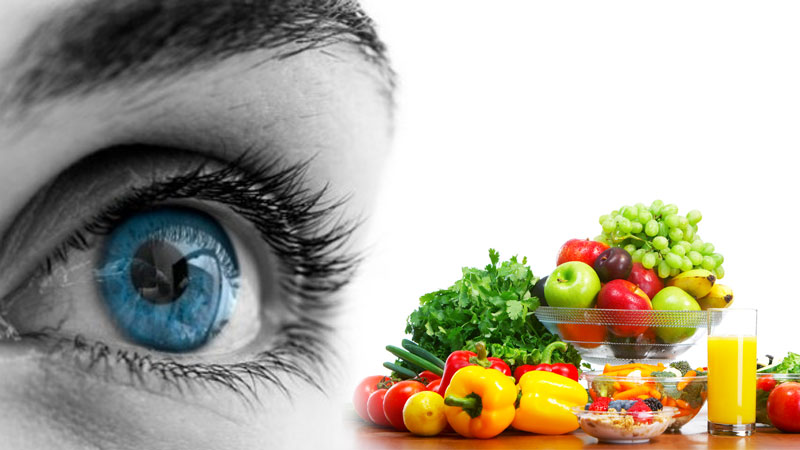
Healthy food is must-have for overall healthy living. However, often the idea of healthy eating is restricted to weight loss, diabetes, heart health and other related issues. There are several other factors that hardly speak about – eye health being one such instance. Eyes are an equally important organ in our body that need proper care to keep up healthy eyesight.
Nutrition and Eye health go hand in hand. Hence, its important to consider the addition of certain food items in your diet to maintain healthy eyes and vision.
A diet that includes whole foods containing eye-enhancing nutrients can help to ensure an individual is getting the nutrients they need to maintain proper vision and eye health. Before moving on to the suggestive nutrients for Eye health lets, discuss about the increased Eye Fatigue since the pandemic broke out.
Asthenopia can be caused by overuse of the eye, for example during a period of prolonged focus on a screen. Any glare on the screen can further strain the eyes. Children with eye fatigue may complain of headaches, eye pain, or feeling tired, headaches. They may lose interest in tasks such as reading.
Undoubtedly, there has been an unprecedented jump in the screen time that we have all engaged in ,whether it is for educational purposes, or for entertainment and leisure or for work, a full-fledged digital lifestyle has increasingly come to define us. Indeed, as part of this lifestyle change, work-from-home has become a more permanent feature of our everyday routine.
The increased screen time and the resultant eye problems can be gauged through a range of symptoms. These could be in the form of eye strain, headaches, blurred vision or double vision, dry eyes or even neck and shoulder pain. Sometimes, it can even lead to disturbance in sleep patterns and difficulty in concentration.
What should one do?
Of course, reducing or ‘right-sizing’ the screen time is the first step that one has to consider. Second, placing the computer or other screen in sufficiently lit space must become a priority. Third, adequate distance — preferably at an arm’s length — and at appropriate viewing angle between the individual and the screen must be maintained. Fourth, glasses and lenses filtering blue rays and with UV protection should be taken recourse to.
At Nutrishilp we begin the consultation for Eye care with a question –
Do you eat what looks good to the eyes or what is good for the eyes ?
By Adding vitamins , powerful antioxidants, minerals, and carotenoids which are easily found in various vegetables, fruits and other wholesome food in the diet, you can keep the eyes healthy.
While a healthy and nutrient-rich diet will promote eye health, eating highly processed and high-fat foods may increase the risk of eye problems. Other factors, like diabetes and dehydration, can lead to chronic vision and eye conditions.
Lets discuss which Vitamins and Nutrients May Be Beneficial for Eye Health?
• Lutein and zeaxanthin: These phytochemicals are found to lower the risk of age-related macular degeneration and cataracts as well as other chronic eye diseases.
• Essential fatty acids: “Good” fats play an important role in fueling cells and optimizing central nervous system function. Omega-3 fatty acids, particularly eicosapentaenoic acid (EPA) and docosahexaenoic (DHA), are vital in vision development and maintaining proper eye and retinal function.
• Vitamin C, or ascorbic acid: In addition to lowering the risk of developing cataracts, this antioxidant can help to slow age-related macular degeneration and vision loss, especially when taken with other eye-healthy nutrients.
• Zinc: Heavily concentrated in the eye, this trace mineral helps to transport vitamin A from the liver to the retina, where it helps to produce melanin, a pigment needed to protect the eyes.
• Vitamin E: This antioxidant protects eyes from harmful free radicals — unstable molecules that damage healthy tissue.
Having understood the vitamins and nutrients good for eye health, lets discuss the commonly available sources for the same.
Which Foods Are Best for Eye Health and Vision?
The best foods for eye health and vision will be those that offer the nutrients known to support eye health and function.
• Fish: Manly fish (those that have oil in their gut and body tissue) are excellent sources of omega-3 acids. Fish with ample EDA and DHA include tuna, sardines, trout, mackerel, and herring.
• Amla : The Indian superfood‘Amla’ not only helps boost immunity but also strengthen our eyesight, carotene in amla improves vision and promotes overall eye health.
• Broccoli: An easy add-on to many dishes, broccoli offers vitamin C as well as lutein and zeaxanthin.
• Nuts and legumes: Some nuts are rich in omega-3s as well as vitamin E, making them a smart and easy source of eye-healthy nutrients. Healthy choices include walnuts, cashews, Brazil nuts, and lentils.
• Seeds: Many seeds, including hemp seeds and chia seeds, are also rich in omega-3 and vitamin E. If you take these seeds along with other nutrients, they can reduce age-related macular degeneration (AMD).
• Citrus fruits: Such as grapefruit, orange and lemon are known to be rich in vitamin C, which is very helpful in curing eye diseases. This antioxidant can fight age-related eye problems.
• Eggs: With omega-3s, lutein, and vitamin E, protein-rich eggs are a powerhouse of eye support health. Certain varieties, including some free range and organic brands, boast having double the omega-3s of other eggs and substantially more vitamin E and lutein as well.
• Leafy greens: In addition to providing vitamin C, leafy greens like spinach and kale are high in lutein and zeaxanthinwhich protect eyes from sunlight damage and reduce the risk of cataracts.
• Carrots: Have long been suggested by our elders for having good eye vision. They are rich in beta-carotene and vitamin A, which play an important role in eye vision. It has a protein called rhodopsin that helps retina in light absorption.
• Dragon Fruit : These days, you can easily find it in your nearby market and it does help a lot in getting better eyesight. The antioxidants present in this fruit can nourish and protect the cornea of the eye.
• Custard Apple : This sweet fruit has a good amount of vitamin B, C and potassium; and it has been proven that potassium-rich foods can reduce the excess fluid under the skin that causes puffy eyes.
• Apricot: Apricots are a common summer fruit that are also used in Indian cooking; they are then dried and saved for later consumption by many.
Moreover,
• Drinking plenty of water to avoid dehydration and dry eyes,
• Maintaining a healthy weight,
• Managing blood sugar and
• Avoiding to smoke may also help more to have a good eye sight.There are certain dietary habits which may put you at prone to risk your vision –
An unhealthy diet of highly processed foods that lack nutritional value may not provide an individual with enough nutrients to support optimum eye and vision health. In fact, research suggests that a high-fat diet of processed foods may increase the risk of developing age-related macular degeneration (AMD).
Other potential diet dangers to eye health include the following:
• Dehydration: Adequate water and hydration are essential to many aspects of health, and vision and eye care is no exception. Not drinking enough water can lead to dry, irritated, or itchy eyes.
• High sodium: Regular intake of high-sodium diet may attract the risk of cataract.
• Diabetes: Diabetes can cause short-term and long-term blurred vision. Diabetes-related eye conditions are progressive and may get worse with time. Complications may include diabetic retinopathy, which can lead to blindness.
• Refined carbohydrates: Those at risk of developing age-related macular degeneration may benefit from eating fewer refined carbohydrates in their diet. Diets that provide a higher glycemic index, such as those high in refined carbs, may increase the risk of AMD progression. Refined carbohydrates are highly processed grain products. The refining process often removes vitamins and nutrients as well as fiber. Examples of refined carbs include white bread, baked goods like muffins and cookies, and pasta.
Following can be put in the list of worst foods for your eyesight include:
• Plain-colored foods (white rice, flour, etc.)
• Saturated fats
• Fatty meats
• Margarine
• Condiments
• Toppings
• DressingsThese food are high in fats or sugars and lack vital micronutrients and contain few vitamins. A diet consisting of only these food puts you at risk of eye diseases.
“ With marginal increase in screen time , one must observe the 20-20-20 rule meaning that every 20 minutes, a person using screen should look about 20 feet away for at least twenty seconds. This would give the eyes much-needed rest on a regular basis.”
Shilp Goel – Dietitian and Nutritionist, Founder Nutrishilp
-
Diet For Dark Circle
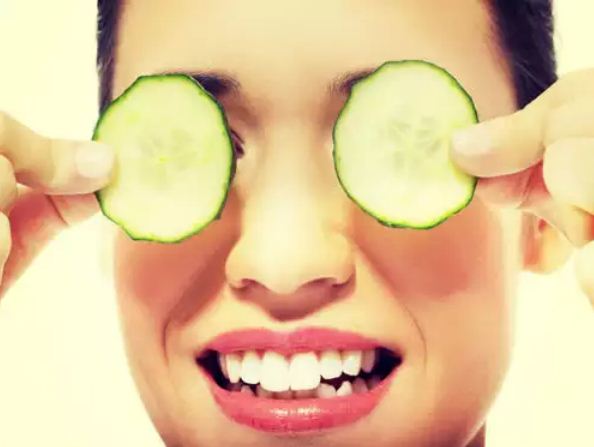
These are very common aesthetic issues and centered around eyes. Skin under the lower eyelids getting darkened can be termed as Dark Circle. And the puffy fats pockets deposited below the eyes are under eye bags.
They may invite unwanted comments about how tired you look. In fact, there are many reasons for dark circles. It’s not always from a lack of sleep.
Though they can affect anyone, dark circles are more common in: older adults
people with a genetic predisposition to this condition Causes of dark circle
Fatigue
Extreme fatigue, or just staying up a few hours past your typical bedtime can cause dark circles to form under your eyes. Sleep deprivation can cause your skin to become dull and paler. The dark tissues and blood vessels beneath your skin can start to show. Lack of sleep may also cause fluid to build underneath your eyes, causing them to appear puffy. The dark circles you see may actually be shadows cast by puffy eyelids.
Age
Natural aging is another common reason for dark circles beneath your eyes. As you get older, your skin becomes thinner. There may be a decrease in the fat and collagen that maintains your skin’s elasticity. As this occurs, the dark blood vessels beneath your skin become more visible, causing the area below your eyes to darken.
Eyestrain
Staring at your television or computer screen may cause strain on your eyes. This strain can enlarge the blood vessels around your eyes. As a result, the skin surrounding your eyes can darken.
Allergies
Allergic reactions and eye dryness can trigger dark circles. When you have an allergic reaction, your body releases histamines to fight off the invader. This causes several symptoms, including itchiness, redness, and puffy eyes. Histamines also cause your blood vessels to dilate and become more visible beneath your skin.
Dehydration
Dehydration is a common cause of dark circles under your eyes. When your body is not well hydrated, the skin beneath your eyes begins to look dull and your eyes look sunken. This is due to the eyes’ close proximity to the underlying bone.
Sun overexposure
Sun exposure can cause your body to produce an excess of melanin, the pigment that gives your skin color. Too much sun — particularly for your eyes — can cause pigmentation in the surrounding skin to darken.
Genetics
Family history also plays a part in developing dark circles under your eyes. It can be an inherited trait seen early in childhood. Over time, the dark circles may lighten or get darker.
Predispositions to other medical conditions — such as thyroid disease — can also result in dark circles beneath your eyes.Anemia
Salt is responsible for water retention in the body. Anemia is when your levels of red blood cells are lower than normal and it is linked with your iodine intake.
Food for Dark circles
Your skin is the mirror of your health, whatever you consume reflect on your skin thus to deal with dark circles, take charge of what you eat,
These foods can go a long way in helping you remove dark circles naturally.
1.Tomato
Tomatoes help protect the delicate skin under the eyes by boosting blood circulation and keeping the skin healthy.
2.Cucumber
Cucumber has high water content that rehydrates the skin. Consuming cucumber also helps to boost collagen production and fights uneven tone of skin. This fruit is also rich in vitamins K, A, E, and C that improve coagulation, elasticity of blood vessels, and blood clotting.
3.Watermelon
Watermelon is rich in antioxidants including beta carotene that supports eye health. It contains 92% water which helps it hydrate the body. It also contains vitamins B1, B6, and C as well as potassium and magnesium.
4.All foods rich in vitamin E
Food rich in vitamin E help to fight enzymes that break the skin elasticity. Vitamin E fights free radicals which cause wrinkles and ageing. It also helps to remove blemishes and dark circles. Foods like almond, peanuts, sunflower seeds, spinach, and broccoli are good sources of vitamin E.
5.Green vegetables
Eating green veggies improves the texture of the skin by boosting blood circulation. Green veggies like spinach and broccoli are rich in vitamin K that plays an essential role in promoting blood circulation to reduce discoloration and puffiness.
6.Orange
Orange is rich in vitamins C and A, both of which help to increase collagen and remove free radicals from the skin.
7.Beetroot
The red pigment in beetroot comes from betalain antioxidants that help to detoxify the body and are good for eye health. Apart from this, beetroot is rich in dilate, magnesium, and vitamin c that helps to reduce dark circles.
8.Papaya
Papaya is rich in vitamin A which helps to get rid of dark circles and it also has anti-ageing benefits for the skin. It also boasts of magnesium and vitamin C. It is also known as a natural bleaching agent that helps to remove dark circles and clear the skin.
9.Water
Drinking water helps to reduce dark circles and puffiness below the eyes. Water helps to flush out toxins from the body and reduces salt concentration around the eye area.
Many people run after supplements and creams to get rid of dark circles. This is not a permanent solution. To get rid of dark circles, you need to have a proper and healthy diet, drink enough water, and sleep for at least seven to eight hours at night. This will definitely help to reduce dark circles.
And do not strain your eyes anymore over the internet to search for the right assistance Call @ 7581921000 or leave your query at contact@nutrishilp.com to get appropriate nutritional and dietary assistance from team Nutrishilp.
-
Diet in Psoriasis
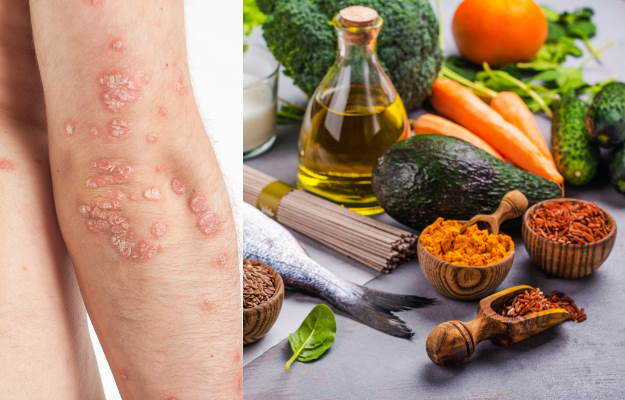
“Excess is always harmful this universal principles holds true for our body cells too.”
Usually in a healthy human body ,new skin cell replaces the old cell inb10 to 30 days but for few the new skin cell build up in 3 to 5 days only,resulting the old skin deposit as scale over the new one and also causes severe inflammation.
This hyper active mode of cells can be medically termed as psoriasis . Although psoriasis is not contagious but may transfer through genes in heredity.
When you have psoriasis, reducing triggers is an important part of managing your condition and avoiding flare-ups. Psoriasis flare-ups can be caused by a variety of triggers. These triggers may include bad weather, excess stress, and certain foods.
Diet plays an important role in dealing with psoriasis.
Foods to avoid –
- Red meat and dairy
- Gluten
- processed meats ,any processed foods high in sugar, salt, and fat
- Foods to avoid include:
- tomatoes,potatoes,eggplants and peppers
- Alcohol
Foods to eat if you have psoriasis
- Fruits and vegetables – broccoli, cauliflower and leafy greens ams fruits as berries
- Fatty fish
- oils that have a higher ratio of omega-3 to omega-6 fatty acids.
If you are detected with psoriasis , you need to understand what goes in your stomach reflects on your skin. You shold be strict on your diet and seek expert guidance to avoid the worsening of the conditions.
Do not allow ingridients to trigger the inflammation.
For nutritional assistance, feel free to conect with Nutrishilp
Call at 7581921000 or leave your query at contact@nutrishilp.com
-
NO NO NO…. NOODLES
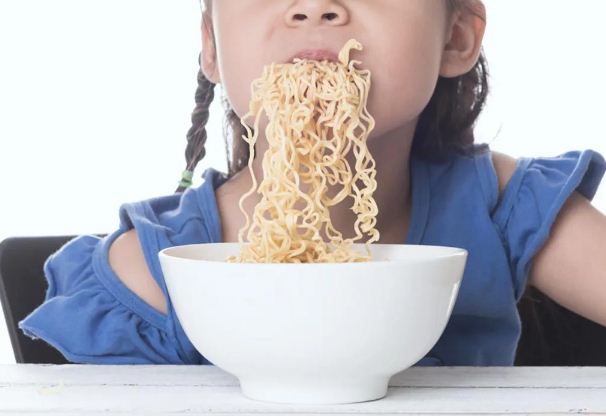
“Mamma noodles” cries the child.
“No” frowns the mother…Now crying in loop begins…. ‘NO….NO…NO…NOODLES’, I love noodles!
NO. NO..NO…NOODLES is perhaps the most common child rap in our Indian homes.
Most of the parents fail to make the child understand why Noodles are not good for health and the child takes it as disciplinary action, as if the war is between mama’s menu VS Noodles.
While you are reading this blog, Team Nutrishilp urges you to make your child also read this, so from the next time it may become easier for you convince him for NO NONO to NOODLES.
Noodles are the most favorite junk food among young people of all age groups. Whether eaten as a snack, tiffin or midnight hunger pangs, noodles is the first choice. Noodles contain an excess amount of carbohydrates that are converted by our body into sugar, which if not utilized will deposit as fat in our body.
Noodles are very low in nutrients and it is advisable to not be eaten as a staple diet. Frequent consumption of noodles is linked to a poor diet quality and an increased risk of metabolic syndrome.
There is also one more quiet popular variant of noodles is INSTANT NOODLES, which has gained popularity among working professionals as an easy – quick food option. Just add water and eat.
But it should be known that to give the instant noodles a longer shelf life, they are highly processed. The noodles are high in fat content, calories and sodium and are laced with artificial flavors, preservatives, additives and flavorings. Though they are inexpensive and easy to prepare, they have adverse effects on our health.
Let’s discuss in detail why noodles are not good for health, as they contain–
• Monosodium Glutamate (MSG)
The monosodium glutamate (MSG) in noodles particularly the instant variant, is reason enough to avoid them. MSG is an excitotoxin, which means it overexcites your nerve cells to the point of damage or death, causing brain dysfunction and damage to varying degrees — and potentially even triggering or worsening learning disabilities, Alzheimer’s disease, Parkinson’s disease, and more.MSG is the perfect obesity drug. If you want to achieve your ideal body weight and health, avoid MSG at all costs.
• Cause metabolic syndrome
Metabolic syndrome — a group of symptoms such as central obesity, elevated blood pressure, elevated fasting blood sugar, elevated fasting triglycerides, and low levels of HDL cholesterol.
Having three or more of the symptoms increases your risk of developing diabetes and cardiovascular disease. It is regardless of whether the diet style falls into the traditional or fast-food category.• Low in fiber and protein
Noodles are processed foods, which lead to weight gain. They are also low in fiber and protein, which does not make it the best option for weight loss and does not keep you full.
• Consists Maida
Noodles are made of Maida, which is a milled, refined and bleached version of wheat flour. Maida is very bad for our health because it is highly processed, rich in flavor but devoid of nutrition. Maida noodles are loaded with preservatives and are nothing but a source of empty calories.
• Contain bad fats
Noodles is the worst processed food, which is loaded with saturated fatty acids or trans-fat. They are also filled with edible vegetable oil, sugar, sugar syrup, flavorenhancer and many other agents like these that are not good for your health at all.
• Leads to a poor diet
Instant noodles are associated with poor overall diet quality. Due to noodles, people are lacking in essential nutrients which are required by the body. Noodles significantly decrease the intake of vitamins A, C, D, calcium, phosphorous, and iron.
• High in sodium
Noodles are high in sodium that has a negative effect on people who are salt-sensitive. And also in general, noodles may cause an increase in blood pressure and also an increase in cardiovascular diseases.
• Lack in nutrient absorption
Children who consume instant noodles frequently do not have the ability to absorb nutrients from other nutritious foods. After the consumption of noodles, many children showed difficulty in absorbing the nutrients from proper meals.
• Obesity
Instant noodles cause obesity, as it contains fat and large amounts of sodium, which causes water retention in the body. Eating noodles daily will lead to weight gain faster.
• Contains Propylene Glycol
Noodles contain propylene glycol, which is an anti-freeze ingredient that prevents the noodle strands from drying by retaining moisture. The body absorbs it easily and it accumulates in the heart, kidney, and the liver, which thereby damages the immune system.
Well, now you may ask Dear Nutrishilp, enough of demerits of my favorite Noodles which but I cannot live without it, yes, I had tried to say NO to it but craving wins over my prudence, what to Do?
Habit replaces habit.so, aim to wipe out this Maida dish from your menu or at least its craving as a staple food, start with replacing your noodle pack with littlebetter options as –
- Sobo noodle (made up of buckwheat)
- Chickpea pasta
- Veggie noodles
- Red lentil pasta
- Semolina(rawa/suji) or whole wheat pasta
These alternatives may at least help you to wipe off Maida noodles from your list.
For the next time when you drop a big pack of noodles in your shopping cart , do check its nutrients, put it back if contains MSG , even if a particular brand doesn’t, pick a small pack and target to wipe it off from your list .
“Eat for your gut, not just your tongue, occasionally eating a package of noodles clearly won’t kill you, but when you make a habit of substituting convenience foods for real food, it’s only a matter of time before health problems will likely develop.”
-Shilpi Goel – Dietitian and Nutritionist
-
Gut- the second brain …
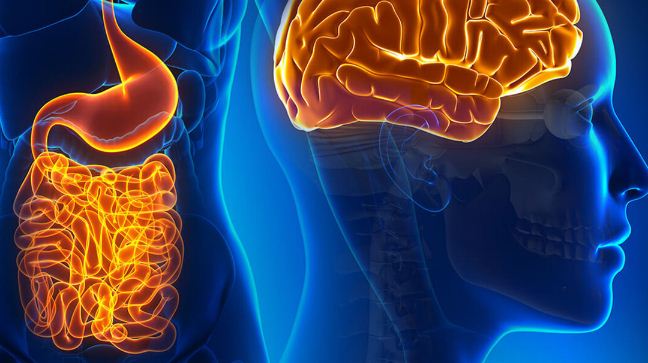
It has long been said that humans have “gut feelings” about things, but how the gut might communicate those “feelings” to the brain !! It has been shown that gut microbiome living in the digestive tracts of humans, can send signals to the brain and vice versa, your gut can be loosely called ‘the second brain’.
The human body is full of trillions of bacteria, viruses and fungi. They are collectively known as the microbiome, while some bacteria are associated with disease, others are actually extremely important for your immune system, heart, weight and many other aspects of health.
The tube in your body that food passes through when it leaves your stomach is called ‘Gut’ and together your small and large intestines are about 15 feet or more in length and much of these microbiome exist mainly inside your intestines , your gut.
Explore the gut with Nutrishilp.
Gut Microbiome
Living inside of your gut are 300 to 500 different kinds of bacteria containing nearly 2 million genes. Paired with other tiny organisms like viruses and fungi, they make what’s known as the microbiota, or Gut Microbime, commonly addressed as Gut Bacteria.
Like a fingerprint, each person’s microbiota is unique: The mix of bacteria in your body is different from everyone else’s mix. It’s determined partly by your mother’s microbiota — the environment that you’re exposed to at birth — and partly from your diet and lifestyle.
The bacteria live throughout your body, but the ones in your gut may have the biggest impact on your well-being. They line your entire digestive system. Most live in your intestines and colon. They affect everything from your metabolism to your mood to your immune system. Most of them are extremely important for your health, while others may cause disease.
GUT Bacteria and Digestion
Since your gut bacteria line your intestines, they come into contact with the food you eat. This may affect what nutrients you absorb and how energy is stored in your body. For example, humans can’t digest fiber but certain gut bacteria can. By digesting fiber, these gut bacteria produce a number of chemicals that benefit gut health and possibly promote weight loss. Your gut bacteria also digest certain antioxidants found in plants known as flavonoids, which may help prevent weight gain .
Your gut bacteria can influence how dietary fats are absorbed in the intestines, which may affect how fat is stored in the body .
Important Functions of Gut Bacteria
• Fermentation of non-digestible food residues such as starch and cellulose with provision of energy both to the host as well as the intestinal flora
• Synthesis of vitamin K which is essential for production of clotting factors; gut bacteria also synthesize biotin and folate which are essential nutrients
• Aid absorption of dietary calcium, iron and magnesium
• Enhancement of immunity.
• lactic acid is produced from the fermentation of carbohydrates which is done by bacteria called Lactobacilli, which prevents the growth of ammonia producing bacteria and additionally favor ammonia excretion. Both these effects reduce the blood levels of ammonia which is toxic to the body. It also reduces the risk of colon cancer by decreasing the synthesis of cancer causing chemicals by harmful gut bacteria.
• Prevent disease by competing with disease causing bacteria for nutrients and attachment to epithelial cells, thereby preventing entry of harmful bacteria into the intestinal cells.
• Good gut bacteria have been shown to promote oral health and reduce incidence of bad breath, dental caries, and throat infections.
An imbalance or sudden change in the composition of the microbiota known as dysbiosis manifests a variety of health concerns.
Some effects of dysbiosis, such as stomach upset, are temporary and mild. In many cases, your body can correct the imbalance without treatment. But if your symptoms become more serious, you’ll need to see your doctor for diagnosis.
What causes dysbiosis ?
When dysbiosis happens in your GI tract, it’s typically the result of:
a dietary change that increases your intake of protein, sugar, or food additives
accidental chemical consumption, such as lingering pesticides on unwashed fruit
drinking two or more alcoholic beverages per day
new medications, such as antibiotics, that affect your gut flora
poor dental hygiene, which allows bacteria to grow out of balance in your mouth
high levels of stress or anxiety, which can weaken your immune system
unprotected sex, which can expose you to harmful bacteria
Dysbiosis is also common on your skin. It can be caused by exposure to harmful bacteria or an overgrowth of a single type of bacteria.
Nutrishilp guide to healthy gut
What you eat directly influences the makeup of bacteria in your gut.A healthy gut helps keep chronic diseases like heart disease and cancer at bay, and also can reduce inflammation, keep your brain healthy and help you maintain a healthy weight. It’s never too late to change your diet to support better bugs in your gut. Research shows that switching from a mostly animal-based diet to a mostly plant-based diet (and vice versa) can change the makeup of your microbiome in as little as 24 hours.
- Eat a diverse range of foods
There are hundreds of species of bacteria in your intestines, each of which plays a specific role in health and requires different nutrients for growth.
Generally speaking, a diverse microbiome is considered a healthy one. This is because the more species of bacteria you have, the more health benefits they may be able to contribute to for your system.- Eat lots of vegetables, legumes, beans, and fruit
Fruits and vegetables are the best sources of nutrients for a healthy microbiome.
They are high in fiber, which your body can’t digest. However, certain bacteria in your gut can digest fiber, which stimulates their growth.Beans and legumes also contain very high amounts of fiber. Some high fiber foods that are good for your gut bacteria include: raspberries, green peas, broccoli, chickpeas, lentils, beans, bananas and apples.
Following a diet rich in fruits and vegetables prevented the growth of some disease-causing bacteria .Bifidobacteria are considered beneficial bacteria, as they can help prevent intestinal inflammation and enhance gut health.
- Eat fermented foods
Fermented foods have undergone a process in which the sugars they contain are broken down by yeast or bacteria.Fermented foods like yogurt, sauerkraut, kombucha , fermented soybean milk, are rich in lactobacilli, a type of bacteria that can benefit your health.
- Eat prebiotic foods
Prebiotics are foods that promote the growth of beneficial bacteria in the gut.
They are mainly fiber or complex carbs that human cells cannot digest. Instead, certain species of bacteria in the gut break them down and use them for fuel.Many fruits, vegetables, and whole grains contain prebiotics, but they can also be found on their own.Resistant starch can also be a prebiotic. This type of starch is not absorbed in the small intestine and passes into the large intestine, where the microbiota break it down.
Many studies have shown that prebiotics can promote the growth of several types of beneficial bacteria, including Bifidobacteria.
Certain prebiotics have also been shown to reduce insulin, triglyceride, and cholesterol levels in people with obesity, which could be beneficial for the prevention of conditions like heart disease and type 2 diabetes .
- Breastfeed for at least 6 months
This old school advice is truly reasonable; a baby’s microbiome begins to properly develop at birth. During the first 2 years of life, an infant’s microbiome is continuously developing and is rich in beneficial Bifidobacteria, which can digest the sugars found in breast milk. Breast feeding is also associated with lower rates of allergies, obesity, and other health conditions that may be due to differences in the gut microbiota.
- Eat whole grains
Whole grains contain lots of fiber and nondigestible carbs, such as beta-glucan. These carbs are not absorbed in the small intestine and instead make their way to the large intestine to promote the growth of beneficial bacteria in the gut.
- Eat a plant-based diet
A number of studies have shown that vegetarian diets may benefit the gut microbiome, which may be due to their high fiber content.Plant foods are rich in specific nutrients that can increase levels of beneficial bacteria and decrease harmful strains of bacteria to support gut health .
- Eat foods rich in polyphenols
Polyphenols are plant compounds that have many health benefits, including reductions in blood pressure, inflammation, cholesterol levels, and oxidative stress but human cells can’t always digest polyphenols as they aren’t absorbed efficiently, most polyphenols make their way to the colon, where they are digested by gut bacteria . Some examples of foods rich in polyphenols are cocoa and dark chocolate, red wine, grape skins, green tea, almonds ,onionsectc.
- Increase your intake of probiotics
Probiotics are live microorganisms, usually bacteria, that provide a specific health benefit they don’t permanently colonize the intestines in most cases. However, they may benefit your health by changing the overall composition of the microbiome and supporting your metabolism .
Good Gut Bacteria and Common Drugs
Have you experienced an upset stomach with a course of antibiotics! Antibiotics target bacteria by taking advantage of structures and processes that bacterial cells have that are different from our own cells. So, while antibiotics don’t harm our own cells, they can kill both good and bad bacteria living in your intestines.
These drugs result in antibiotic-like side-effects and may promote antibiotic resistance. Thus over use or consuming the antibiotics without a prescribed advice may invite a usually unnoticed risk that consumption of non-antibiotic drugs may promote antimicrobial resistance, as the general resistance mechanisms of microbes to human-targeted drugs and to antibiotics seem to largely overlap.
Not all drugs will impact gut bacteria and not all resistance will be common. In some cases, resistance to specific non-antibiotics will trigger sensitivity to specific antibiotics, opening paths for designing optimal drug combinations.
Gut bacteria – Interesting Facts
• Gut flora are partially inherited from the mother at birth and the other half is determined by lifestyle factors such as dietary intake, stress, and age.
• A newborn baby is sterile and bacteria colonize the exposed lining of the digestive tract by entering through the oral pathway.
• The diet and nutrients received help in creating the microbial environment in the digestive tract.
• The composition of gut flora keeps varying from time to time and is unique for each individual based on lifestyle factors, exercise, stress, illness, travel, and age.
• Gut bugs are flexible and change according to the needs of the diet. .“ For a healthy gut… remember this simple Nutrishilp equation .
Healthy Gut = Diet +( Probiotics, prebiotics, fiber, polyphenols and fermented foods ) – (Artificial sweeteners, red meat, processed foods and alcohol)”
-ShilpiGoel, Dietitian and Wellness Expert.
-
Building muscles in the kitchen (Diet to build muscles)
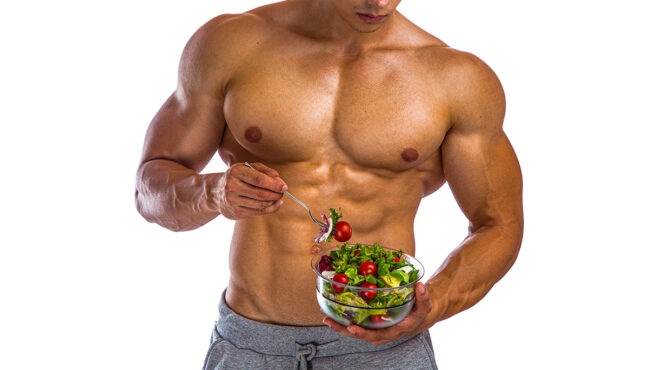
The most common reason people want to build muscle is to bulk up and improve their physique and strength, have you been exerting yourself for hours in the gym or gobbling down those tasteless protein powders to build muscles! Well, you might be missing out on something that effortlessly gives your fitness regime a healthy boost; and gives your body the right amount of nutrition to build strong muscles. Nutrishilp suggests a few health enriching foods that help in building muscles naturally by just tweaking the diet.
The appropriate diet is one of the most important factors in building muscle and is key to achieving your personal training objectives. In order for your diet to complement and support your muscle building efforts, there are a few things you need to check and determine in advance.
Nutrition for muscle building
Macronutrients are the nutrients we need in larger quantities that provide us with energy.
When trying to build muscle, it is particularly important to regularly consume much needed macro nutrients like high-quality proteins, complex carbohydrates and polyunsaturated fatty acids.
Protein: Essential muscle building component
When building muscle mass, a high-protein diet is needed to support the body after exercise and during regeneration. Proteins basically consist of various essential and semi-essential amino acids like leucine, valine and isoleucine. Only a regular supply of protein can permanently boost protein synthesis for muscle building and keep the amino acid concentration in the blood consistently high.
Carbohydrates: Fuel for your muscles
Avoid simple carbohydrates: Often known as bad carbohydrates, e.g. the sugar in fruit juice and honey.
A nutrition plan for muscle building should always focus on the supply of complex carbohydrates. These carbohydrates are processed slowly, keeping blood sugar levels stable and supplying the body with energy long-term.Only with a sufficient carbohydrate intake can you maintain permanent progression (consistent weight increase).
If you consume more carbohydrates than you need, your muscles store the remaining sugar in the form of glycogen. During intense workouts in particular, your body can tap into these energy reserves.
Primarily whole grain products, potatoes, brown rice and oatmeal should be included in your nutrition plan for muscle building. Short-chain carbohydrate compounds such as glucose should be avoided, as these raise blood sugar levels very quickly.
Fats: quality not quantity
In addition to carbohydrates and proteins, a good supply of healthy fats plays an important role in a muscle building diet.
Certain body functions like the release of testosterone and hormone production require valuable fatty acids. Unsaturated fatty acids from plant oils (flax oil, organic coconut oil), fish (cod, salmon), avocado and walnuts are ideal.
Too many of the bad fats will lead to a decline in physical and mental performance potential long-term but Essential fatty acids are your secret weapon which can be found in olive oil, coconut oil, nuts and low-fat fish.
Water –
It’s very essential to stay hydrated.
The ability for your muscles to regenerate effectively is promoted by a sufficient intake of fluids.
Regardless of your goals – whether you’re trying to build muscles or define them – water is THE nutrient for your body.
Nutrishilp recommends to increase your water intake on workout days to compensate for the fluid lost during exercise. In addition to Macronutrients, you also need to regularly consume vitamins and minerals which can be collectively addressed as Micronutrients –
They also play important roles in supporting your performance. They can directly affect your energy levels for output, muscle recovery and maintenance, and potentially reduce your risk of illness or injury While all nutrients are important, here are some micro nutrients you should be paying attention to when it comes to fitness:
Vitamin D, Vitamin E, Vitamin B12, Iron, Zinc, Magnesium, Potassium and Calcium.
Say goodbye to hunger pangs
A well-planned muscle building diet usually includes the required amount of daily calories. Without a calorie surplus, your muscles cannot grow consistently.
THE TALISMAN OF PROTEIN
Every cell in the human body contains protein. The basic structure of protein is a chain of amino acids. You need protein in your diet to help your body repair cells and make new ones.
Good natural sources of protein
There are various sources from which we get natural proteins.
1: Poultry food
2: Seafood
3: Dairy products
4: Nuts and seeds
5: Tofu and soy productsNutritional supplements for muscle building
An additional intake of dietary supplements can optimize muscle building processes. Commonly used products are :
• Whey Protein: Whey is a liquid that separates from milk during cheese production. The protein part of whey is called whey protein.
It is a complete, high quality protein that contains all of the essential amino acids. In addition, it is very digestible, absorbed from your gut quickly compared with other types of protein.
There are three main types of whey protein powder:
• concentrate (WPC)
• isolate (WPI)
• hydrolysate (WPH)
• Branched-chain amino acids (BCAAs) are a group of three essential amino acids:
leucine, isoleucine and valine
BCAA supplements are commonly taken to boost muscle growth and enhance exercise performance. They may also help with weight loss and reducing fatigue after exercise.• Creatine Powder: Creatine is a substance found naturally in muscle cells. It helps your muscles produce energy during heavy lifting or high intensity exercise. It can help to gain muscle, enhance strength, and improve exercise performance.
• L-glutamine: L-glutamine is the most plentiful amino acid in the body. It’s involved in protein synthesis and serves as fuel for the immune system. L-Glutamine is a building block for making proteins in the body.
Natural Proteins vs Protein Supplements?
Protein in any form – natural or artificial, is essential to carry out normal body functions. Natural source of proteins provides all required carbohydrates, vitamins, and minerals, but they may not provide all essential amino acids. Natural protein sources are mostly animal-based, and might not be a suitable option for vegetarian and vegan people. They contain no preservatives or artificial colors. Some natural protein sources are expensive and require time to prepare.
Protein powders or protein bars are the artificial sources of protein. They provide all essential amino acids in the required quantity. In liquid form such as juices, protein is easy to absorb and digest. These protein supplements are super-convenient and instant to consume. However, protein bars and powders contain artificial colors and preservatives, which can be harmful to the body.
Though there is more convenience in using protein supplementation like protein shakes or protein bars, it is always best to use natural sources. Consume natural food items as much as you can, however, you can also use supplements to fill in the gaps, if advised by your nutritionist.
“Be cautious about what you eat because being fit is 80 % diet and 20 % exercise”
– Shilpi Goel, Dietitian and Nutritionist, Founder Nutrishilp.
-
Subscribe
Subscribed
Already have a WordPress.com account? Log in now.